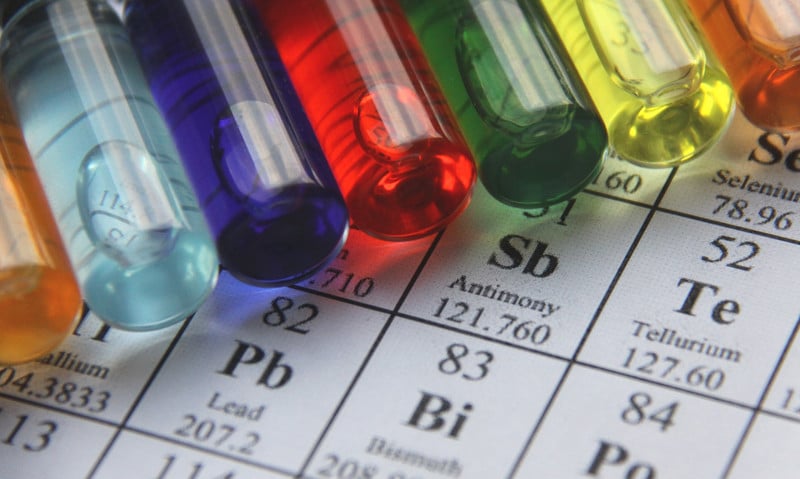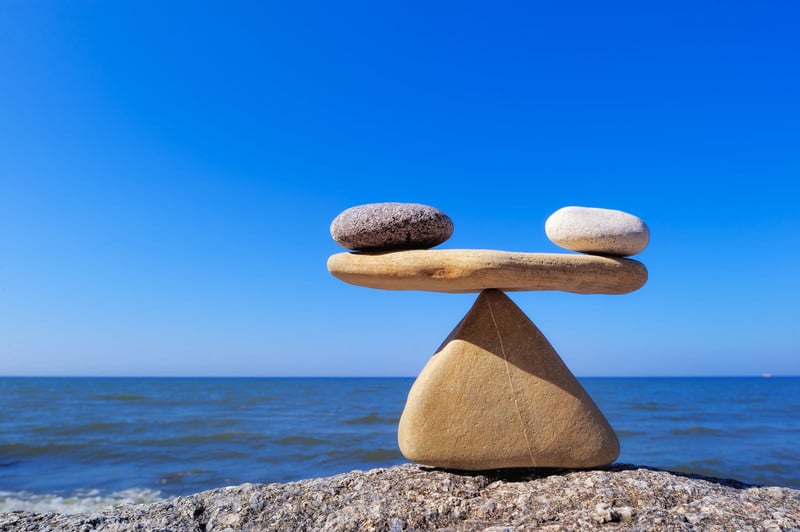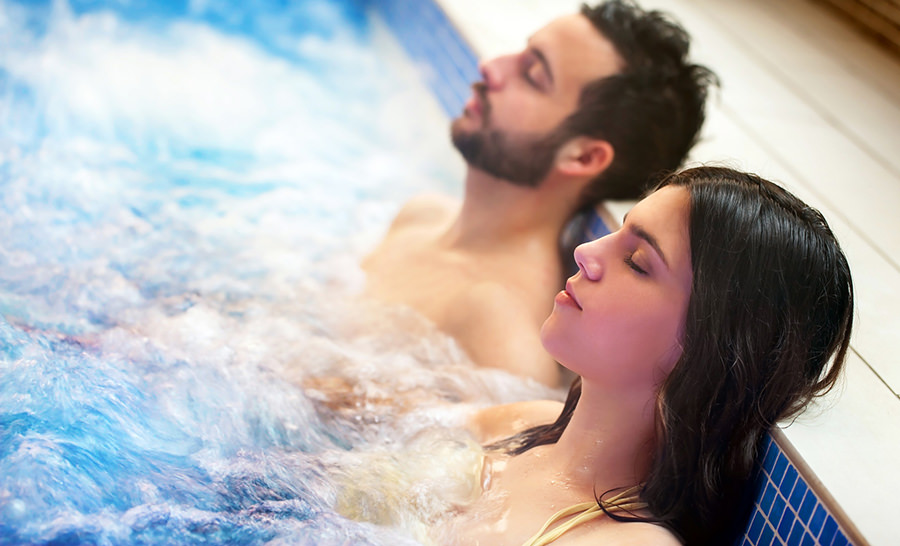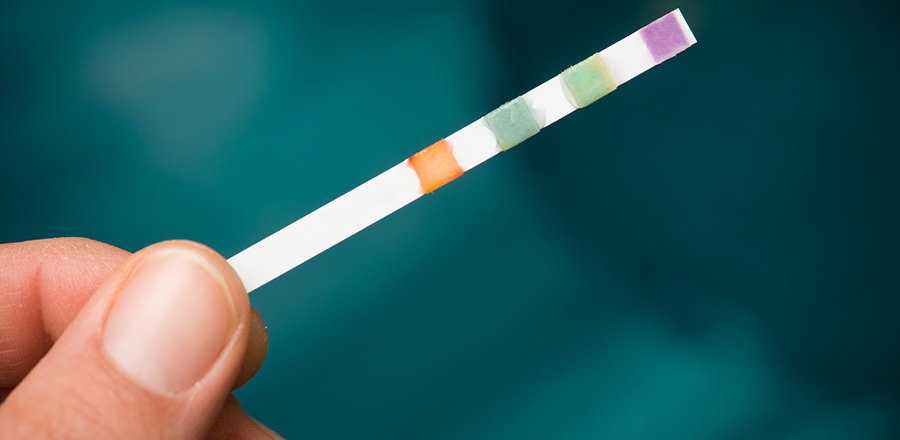
It would be lovely if you could buy a hot tub, fill it with water, switch it on and then just sit back and relax.
You might well be thinking that the whole business of water chemistry and maintenance is a bit complicated. I know that when I first started looking into it, it seemed as though you needed a chemistry degree to be able to understand what to do. But, with a little thought and effort, it’s really not that difficult. All you need to do is to understand a few basic concepts and then to get organized with a regular maintenance schedule and plan. I’ve found that planning and organization really is the key and you will find that once you have a maintenance schedule in place it really takes very little time to keep your hot tub and water sparkling clean.

So, what hot tub cleaning and maintenance do you need to do? Daily – check for debris in the water, check water temperature and check the cover is secure. Twice weekly – check the water alkalinity and PH level, check sanitizer level and shock if needed. Weekly – check water as before, check and top up sanitizer, rinse the filter, wipe down the hot tub. 3-4 monthly – drain and refill the hot tub, chemically clean the filter. Yearly – flush the system and detailed inspection.
The key to success is understanding why you are adding the chemicals. Many people try to just find the solution to individual problems like cloudy water or foam without really understanding the underlying issues. This can mean that you spend ages trying to fix the symptoms of a problem that probably wouldn’t have occurred in the first place if you understood a little about how your hot tub worked. So, before working out a step by step hot tub maintenance schedule, let’s have a look at a little bit about water chemistry.
Here we go!
Why add chemicals to hot tub water?
Imagine a rather strange parallel universe where you fill your hot tub with pure clear water, put the lid on and just leave it there. Now, assuming that the hot tub itself wasn’t harboring any latent bacteria, then theoretically the water would remain pure and clear indefinitely. This would be great as you wouldn’t have to do any hot tub maintenance, keep an eye on your PH levels, check your sanitizer, add shock or even change the water. Sounds like hot tub heaven doesn’t it!
The problem with this, of course, is that we are assuming that the hot tub doesn’t get used at all and that no chemicals need to be added to the water. You see the main problem with hot tub water cleanliness is our very own filthy bodies! Most of the bacteria associated with hot tubs start life having been introduced to the hot tub via the human body. Just think about it for a moment – we are covered in sweat and excrete all sorts of revolting bodily fluids. That’s not even taking into account sunscreen, shower gels, shampoos, makeup and all sorts of other products that can easily find their way from our bodies into the water of your hot tub. You probably don’t even want to know about the science behind the possibility of measuring tiny amounts of feces in
If you add to this little concoction of filth the fact that hot tubs contain a relatively small amount of water per user and also factor in the high temperatures that hot tubs operate under you can soon see why
So what can we do about all this filth?
Well, this is where a rigorous regime of hot tub maintenance comes in.
Hot tub cleanliness – Firstly it’s really important to keep the actual hot tub itself clean both within the shell where you sit and also in the pipework too. Even a small amount of bacteria can soon multiply so it’s important to keep on top of the maintenance and to keep the hot tub physically as clean as possible to prevent bacteria build-up.
Water chemistry – Secondly, the water in the hot tub needs to be treated and cared for to keep it in as clean and hygienic condition as possible. As you are probably starting to realize it’s a bit of a continual battle against the bacteria brought into the hot tub by our bodies and the outside environment and the on-going heat. This is why understanding and implementing a regime of chemical maintenance is so important.
The filtration system – However, the hot tub’s first line of defense against all of this dirt is the filtration system. Modern filtration systems are fantastic at removing dirt and keeping the water clear. They are increasingly able to remove smaller and smaller particles of dirt from the water but they cannot remove the very tiniest microscopic ones. You need to keep your filter clean so that it works most efficiently but it will also need some help from your hot tub chemicals to combat the very tiniest particles. The most important of these is your sanitizer which basically kills bacteria by seeking it out in the water and clinging to it and removing it particle by particle. For your sanitizer to work most effectively the PH and alkalinity of your water needs to be balanced. You will also need to give your sanitizer an occasional boost or “shock”, particularly after heavy use of the hot tub.

With a good and regular maintenance
So why can’t chemicals keep the water clean indefinitely?
It’s to do with something called TDS or total dissolved solids. Imagine filling a glass with water and then adding salt or sugar to it a spoonful at a time. For a while, the salt or sugar will dissolve in the water but
So, what have we learned about hot tub maintenance so far?
Well, we now know that there are three elements that
We know that when dirt, bacteria
We also know that larger particles are removed by the filter and that it’s really important to keep the filter clean by maintaining it at regular intervals.
Finally, we heard the rather uninspiring news that, despite all our best efforts to clean and maintain you will, at some point need to completely drain and refill the hot tub with fresh water as it simply gets too saturated with solids for the sanitizer to cope.
Before we go on, just as an interesting side fact – did you know that cheaper hot tub chemicals leave a solid residue in the water which speeds up the saturation process whilst better quality chemicals dissolve more fully? They will both do their job in the short term but regular use of better quality chemicals will help to lengthen the time between water changes.
What happens if you don’t clean and maintain a hot tub?
Do you really want to know? Basically, the water will become saturated with dirt and bacteria particles, the filter will start to clog, the pump will have to strain to pull around the dirty water and will use more electricity and wear out more quickly. That’s not to mention the fact that the water itself will become cloudy or discolored, you will get foam and other discharge around the water edge and the body of the hot tub may well show signs of mold and discoloration. The water itself might start to smell and, rather than being an inviting haven of warmth and cleanliness, your hot tub will become quite literally, a health hazard. It’s actually possible to catch certain unpleasant diseases from dirty and poorly maintained hot tubs – you have been warned!
So, what maintenance do I need to do on my hot tub?
Hot tub maintenance schedule
The maintenance schedule outlined below is a great starting point. You might want to change it according to the amount of use your hot tub gets and also possibly after consulting your hot tub’s instructions and the directions on the chemicals you have chosen to use. However, the maintenance plan outlined below is a good place to begin.
Start from a fresh fill
Let’s assume that you have just drained and cleaned your hot tub and refilled with fresh water. It’s important, right at the beginning, to get the water chemistry correct as this will set you up for success in the long term. Don’t rush this very first stage as it can be a false economy. If you don’t get it right your water will start to become cloudy more quickly and you will just have to drain it and replace it all over again.
Test the alkalinity and PH levels – Firstly, you need to get both the alkalinity and PH level of the water correct. If you don’t and the water is either too alkaline or too acidic it can lead to skin irritation as well as corrosion of the hot tub itself. You will also find that the effectiveness of the sanitizer that you choose is compromised as well, so take the time to get the foundation of your water chemistry correct by balancing the alkalinity and PH levels carefully.
To do this you will need hot tub test strips to test the water and balancing chemicals. You simply dip a test strip in the water and compare the color it displays with the chart on the test strip bottle. It will then tell you which chemicals you might need to add to correct the water chemistry.
Make sure that the total alkalinity is correct first. It should be between 100 and 120 parts per million. Once this is correct you can then go on and test the PH level using test strips. The pH level should be between 7.4 and 7.6.
If you need to raise the alkalinity then use a hot tub alkalinity increaser.
If you need to lower the alkalinity then use a hot tub PH decreaser
If you need to raise the pH then add a hot tub PH increaser.
If you need to lower the pH use a hot tub PH decreaser.
In order to know how much chemical to use you will need to know how many gallons of water your hot tub holds. This information should be either on the hot tub itself, in the instructions, or you might need to look online or contact your supplier if you are struggling. R
Once you have worked out how much chemical to introduce to the hot tub switch the jets on and scatter the chemical over the surface of the water. Leave the jets on for around an hour so that the chemical gets fully absorbed into the water and then do another test. You might find that you have a perfect result or you might need to balance the water again. Do take your time at this stage to get

Check the calcium hardness level – Once the water is balanced and the PH levels are perfect it’s time to check the calcium hardness level. All water contains varying quantities of calcium and magnesium and it’s possible that if these are incorrect it can lead to excess wear and tear on the internal parts of your hot tub. This only needs to be checked when you replace the water and is easily forgotten as there are no obvious warning signs that it is incorrect.
The ideal level is between 175 and 250 parts per million.
Add the sanitizer – This is the most vital step as the sanitizer basically disinfects the water and kills all the bacteria and nasties. It’s a good idea to add sanitizer right from the beginning so that you are starting off with clean and fresh water.
There are two common types of sanitizer in use in hot tubs. The most popular is chlorine closely followed by bromine. Chlorine is the cheaper of the two and a little easier to use. Bromine has the advantage of not having that familiar chlorine smell but can be a little bit more tricky to apply.
Assuming that you are using chlorine you need to add it to your perfectly balanced water so that the amount of chlorine is at 5 to 8 parts per million. Now, this will give the water a big chlorine boost but it isn’t safe to be in the hot tub with this amount of chlorine in the water. Keep the jets on in the hot tub and wait for an hour or so until the chlorine has decayed a little. The safe level is between 2 and 4 parts per million and it’s important not to enter the hot tub until the chlorine has reduced to this safe level.
Once you have correctly balanced the alkalinity and PH levels of the water, got the calcium hardness levels correct and also boosted the sanitizer and waited for a safe level to return you will be glad to know that your hot tub is safe and ready for you to use!
Let’s go on and look at how you need to regularly continue to clean and maintain the hot tub to keep that water sparkling fresh and clear.
Daily hot tub maintenance
A quick daily check of your hot tub can help prevent small problems developing into bigger issues.
- Check the cover – make sure that the cover is securely fitted so that the warm air can’t escape and the elements can’t get in.
- Check the water temperature – you can use a hot tub thermometer which will give you a temperature read out on an app on your phone or you can check on the hot tub itself. Make any adjustments necessary.
Twice weekly hot tub maintenance
In addition to the daily checks above it’s important to carry out the routine tasks below 2 or 3 times a week.
- Check the alkalinity and pH levels – Use a test strip to check those all-important PH levels and adjust as necessary.
- Check sanitizer levels – check to make sure that the quantity of sanitizer in the water is correct and adjust if needed.
- Check for debris – if there is any debris floating on the water surface then you can catch it with a skimmer net. If you notice any accumulation of dirt or grit in the hot tub itself than a spa vacuum will soon get rid of it.
- Wipe above the waterline – check for any dirt around or above the waterline and wipe it away carefully. Use plain water where possible as using any cleaning products that aren’t specifically designed for the task could contaminate the water.
- Check the water level – make sure that there
isn’t any unexpected variations which could indicate a leak. Top up if needed.
Weekly hot tub maintenance
Again, in addition to the tasks above, set a regular time to carry out the maintenance jobs below each week. Start by checking the PH levels before
- Shock the hot tub – this rather strange sounding activity simply means using a shock treatment to give the sanitizer a big boost. This should be done on a weekly basis or after the hot tub has been used particularly heavily. It’s important to use the correct type of shock treatment to correspond with the sanitizer that you have chosen.
The shock treatment oxidizes the contaminants in the water and releases them as a gas. Once you have added the shock treatment to the hot tub it’s a good idea to leave the pump on so that the water circulates however, keep the jets off. If the water is swirling around too quickly during the oxidation process the gas will be released too quickly and the process will be less effective. Again, just as with adding the sanitizer, it’s important to check that the chlorine levels are safe before entering the hot tub. You might need to leave a period of time between the shock treatment and getting in the hot tub. Check the shock treatments instructions to be sure.
- Rinse your hot tub filter – Take the filter out of its housing, inspect it for debris and give it a good clean with a garden hose. Try to get the water in between the individual cleats of the filter to remove as much debris as possible. You can also use a cleaning wand on the end of your hose if you wish which will make this job a little easier.
- Remove and clean the cover – Try to completely remove the hot tub cover each week and leave it out to air for a few hours. This gives it a chance to recover from the constant heat and moisture and also gives you the opportunity to use a cover cleaner and conditioner on it to keep it in tip-top condition.
Monthly hot tub maintenance
Each month carry out the maintenance tasks above as well as the additional jobs below.
- Chemical filter soak – Rather than just rinsing the filter, follow the rinse with an overnight chemical soak. This literally means soaking the filter in a bucket of filter cleaning chemical overnight which will clean away microscopic particles of debris helping to keep your water
clearer for longer. If you want to use your hot tub during this time it can be a good idea to have a spare filter on the go so that you don’t have to wait for the other one in the soak. Once the filter has hadit’s soak rinse thoroughly with clear water and replace
- Check the cabinet and jets – It’s also a good idea to do a monthly check around the cabinet for any damage or leaks. Have a quick look inside the cabinet as well to make sure that everything looks ok.
Also take the time to check that all of the jets are functioning properly and clean or adjust as necessary.
This is the big one! You will find that your hot tub water will need to be completely drained and replaced every 3 to 4 months. Obviously, this is a big job and one that many hot tub owners try to put off for as long as possible. If your water is smelly or cloudy and adding sanitizer and shock doesn’t solve the problem then it is probably time for a water change. If you don’t fancy doing the full change then a partial change might do the trick. You can also check your water’s TDS level (total dissolved solids level) for a more scientific indication of when your water should be changed. Simply do this by
How to drain a hot tub
- Flush out the plumbing and the jets – Before you empty the water from the hot tub it’s a good idea to use a flushing solution to totally clean out the internal plumbing and jets. Once you have added the solution run the jets on full power for around 20 minutes so that the flushing solution can circulate.
- Drain the water – Switch off the hot tub and remove the drain plug so that the water can drain out. You can use a sump pump to speed up the process and to help remove the very last bits of water.
- Clean the hot tub shell – Use a special hot tub cleaning product to thoroughly clean all the nooks and crannies in the hot tub shell. Make sure that you remove any staining or algae and look really carefully below the waterline for any damage or repairs that might need doing to the shell or the jets. Once the shell is completely clean rinse thoroughly with fresh water to remove any traces of cleaning product.
- Clean the filters – Remove the filters and give them a thorough chemical clean. This means using a specific filter cleaning solution and allowing the filters to soak in it for 24 hours. Use a bucket to make sure that the filters are completely submerged. Before using the chemical it’s a really good idea to wash the filters thoroughly with a hose and also a magic wand attachment to remove any of the larger pieces of debris from the filter. Check carefully between the pleats to make sure that you get
the filter as clean as possible
- Refill with water – Replace the drain plug and replace the filters. Then refill with fresh clean water to the level as per the manufacturer’s recommendation. Add chemicals as described above.

Set up hot tub maintenance reminders.
So, we now know, in quite a lot of detail, the main tasks that are needed to keep your hot tub clean fresh and healthy. As I mentioned above though the real key to success is actually implementing this maintenance schedule! The good news is that, apart from the quarterly water change, it really doesn’t take very long and a few minutes spent regularly will save a lot of time in the long run. You basically need to get into the habit of checking and maintaining your hot tub so that it becomes part of your daily and weekly routine.
A hot tub maintenance checklist
To help you I ‘ve created a simple hot tub maintenance checklist that you can click on and print out. It distills all of the information above into a handy checklist and it might be a good idea to print it and stick it somewhere prominent for easy reference. Maybe on the wall near your hot tub is a good spot or, in my household things like this get stuck on the fridge door.
Click here to download the hot tub maintenance checklist

When you first start implementing the maintenance schedule you will probably find it a bit tricky. To help just think of the other things that you regularly do on a daily weekly and monthly basis. Maybe you let the dog or cat out each day into the garden and this would be a great time to do your daily hot tub check – it literally takes a few moments. The weekly checks could be done when you put the
These are all suggestions of how you can use other regular activities to remind you to do your maintenance tasks on your hot tub. Once you have got into the regular habit of hot tub maintenance it’s really not a big deal. It will become second nature and a habit that’s hard to break.
If you want to be a little more organized and not rely on your memory there’s no reason why you couldn’t write your hot tub maintenance schedule into a diary or onto your calendar. Work in 3-month blocks assuming that you will change the water every three months. You could also set up a series of reminders on a Google calendar. This can be quite quick and easy as you are able to set recurring reminders for regular time periods. If you have a calendar on your phone then you can set notifications in your Google calendar and it will either email you or send you a notification when you’re hot tub maintenance needs to be done. Again, do this in
Record your hot tub’s maintenance
It’s a really good idea to keep a record of the maintenance tasks that you have carried out on your hot tub. In particular, keeping a record of your water test results and what chemicals you used and
Apart from this, it can be quite good fun just to see how your water behaves and to see if you can spot and predict repeating patterns. Over a long period of

Hot tub water testing hints and tips
As you will have realized, testing the water on your hot tub is one of the key components to keeping the water clear and fresh and keeping your hot tub in tip-top working condition. Being able to test the water reliably and consistently is vital. You test the water using test strips which are cheap and easily available however, there are a few things to bear in mind to help ensure that the test strips give the most accurate results.
- Follow the instructions – This might sound a bit obvious but different test strips from different manufacturers potentially have different methods of
use, or at least different methods of reading the results. Also, don’t assume that the instructions will be the same for a new batch of test strips made by the same manufacturer as an old batch. It’s perfectly possible that the new updated batch may have to be used in a slightly different way. Just taking a little bit of care to read the instructions can save a lot of heartache and confusion. Bear in mind that if you do misread your test strips and you add chemicals incorrectly you will, at best shorten the length of time your water will stay clear and in the worst case scenario you could cause irritation to your skin and damage to your hot tub.
- Take care with storage – Again, to ensure the most accurate results store the test strips according to the manufacturer’s instructions. Normally, they should be kept at room temperature in a place with relatively normal humidity. They are best kept in the container in which they are arrived and also out of direct sunlight. Take care to replace the lid on the test strips once you have used one of them.
- Check the expiry date – It’s also worth checking the expiry date on the test strips as well. They are there for a reason and once the test strips go beyond their expiry date the chances of them returning an incorrect reading increase.
- Use dry fingers – When you take a test strip out of the bottle make sure that your hand is completely dry. Obviously, it will be a bit of a disaster for the batch of test strips if water enters the container. Also, if water gets on the test strip before it gets into your hot tub it could potentially skew the reading. If your hands are particularly greasy or sweaty it can be a good idea to wash and dry them before handling the test strips as well, and just to be on the safe side try to handle them by the very edges rather than putting your fingers all over the area that will take the reading
All of the tips and precautions above are designed to help get the most accurate readings from your test strips. Remember that if you read them incorrectly or get an incorrect reading you could potentially put the incorrect amount of chemical in your hot tub creating problems both for you, your skin and your hot tub as well.
As with many things in life, technology is here to help us and you will find that many of the major hot tub manufacturers have apps that will help you to test and look after your water. Obviously, these apps only work with specific brands of
Things that can go wrong
With the best will in the world, even if you keep on top of your hot tub maintenance things can occasionally go wrong. However, if you are careful to shower before you get into the hot tub in plain water
How to get rid of algae in your hot tub
Algae can be caused by a number of issues including not having enough sanitizer, leaving the hot tub open to the elements too much and the algae being transferred by people using the hot tub. Luckily if you do find algae in your hot tub it’s quite easy to fix.
Circulate the water – if you are looking for a quick solution then circulating the water for a while until the algae
Drain and refill the hot tub – this is quite a big job and a bit of a pain but it’s the most effective way to get rid of algae. Make sure that you clean the hot tub shell thoroughly with hot tub cleaner before refilling. It’s also a good idea to clean your filters at the same time in case any of the algae is lurking there.
Try using an algaecide – if you are getting repeated issues with algae you might want to try adding an algaecide to the water.
How to get rid of foam from your hot tub
Foaming water can look a bit gross and is caused by shampoos, deodorants, shower gels and all of the other impurities that we carry on our bodies being stirred up in the hot tub water into a foamy mess.
The easiest way to prevent getting foam in your hot tub is to shower thoroughly in plain water before entering the hot tub and to try and avoid spilling food or drink into it. As with most hot tub issues your first port of call is to check your water pH level and sanitizer level and to adjust if necessary. Having an incorrect calcium hardness level can also cause foaming so check this as well. If none of these steps get rid of the foamy water then your only other permanent option is to drain and refill the hot tub.
Finally, you might find that using cheap chemicals causes an increased amount of foam. This really is
How to clear cloudy water from your hot tub
Cloudy water means that your hot tub water is really struggling. It could possibly be full of bacteria and tiny particles of organic matter all rotting together in a rather disgusting soup. There can be a number of reasons why your water is cloudy, it could simply be that it’s time for a water change or it might be that you have had a significantly higher number of people in your hot tub than usual. Whatever the reason it’s important to address the problem as soon as possible as bathing in cloudy water could potentially transmitted harmful diseases such as Legionnaires disease and also lead to skin rashes another problems.
Check your water chemistry – as usual, the first port of call is to check your pH levels and your sanitizer. Possibly giving the water a shock treatment might do the trick if the water isn’t too cloudy – it might just recover if you do this.
Check the filters – it might be that your filters need a thorough clean. You also need to make sure that the water circulates through the filters for at least an hour every day so that the filtration system can do its job.
Check the TDS levels – if this doesn’t work then check your total dissolved solids level in your hot tub. If this is around 1500 parts per million then it’s time to change the water in the hot tub
Fill the hot tub with filtered water – some water sources have a high level of metals in them and this can cause oxidation problems and cloudy water. You might not realize that you have this issue until your water becomes frequently cloudy. If this is the case, then you can buy a simple hose attachment to filter the water before it reaches your hot tub. It’s also possible to buy a metal sequestrant
Flush the system – remember to flush the system thoroughly before draining the water from your hot tub. This is simply a case of adding a flushing solution to the water and then running the jets on full power for 20 minutes or so before draining the hot tub. This will clear the pipes and workings of the hot tub and flush out any debris that is causing problems.
Final thoughts
Despite at first seeming rather complicated hot tub maintenance is basically fairly straightforward once you have got the gist of it. It’s just a case of keeping up with the regular maintenance schedule and to be honest, this only takes a few moments a week – the time spent will quickly repay itself with consistently clear and fresh water. If you keep up with your maintenance schedule you should find that you have very few issues with your water quality as most of these are caused by not keeping the pH level balanced, not having the correct amount of sanitizer, not shocking the hot tub and not keeping the filters clear and clean.
I hope the above has been really helpful for you and good luck!

